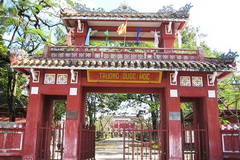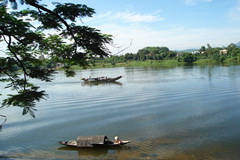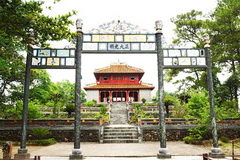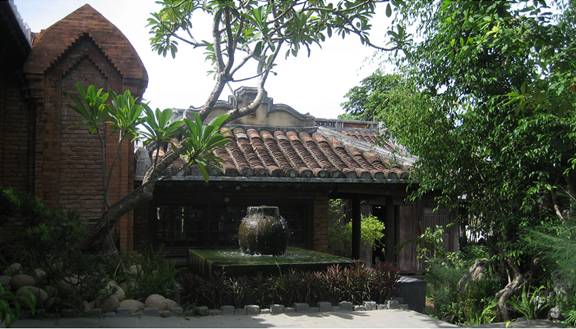



.jpg)
Le mausolée ou tombeau de Tu Duc (en vietnamien: Lang Tu Duc) est le lieu que l'empereur Tu Duc -qui règna sur l'empire d'Annam (aujourd'hui Viet Nam) de 1848 à 1883 - fit construire pour sa sépulture future.
En fait, il fut enterré à Hué dans un autre lieu tenu secret.
Le mausolée, qui servait également de résidence de campagne, se trouve à six kilomètres au sud-ouest de l'ancienne ville impériale de Hué. Il s'appelait le domaine de Khiem du vivant de l'empereur.
Le tombeau de Tu Duc est l’un des plus impressionnants tombeaux royaux de Hué et il s’élève dans un cadre naturel enchanteur.

L’école nationale de Huê se trouve sur la rue Lê Loi, quartier de Vinh Ninh, ville de Huê, province de Thua Thien-Hué.Quoc Tu Giam fut l’Ecole Nationale ouverte par la Cour pour former les élites intellectuelles de l’état. Au...
.jpg)
Établie comme capitale du Viet Nam unifié en 1802, la ville de Huê a été non seulement le centre politique mais aussi le centre culturel et religieux sous la dynastie Nguyên, jusqu'en 1945. La rivière des Parfums serpente à travers la...

La rivière des Parfums (Sông Hương) tire son nom des nombreuses herbes médicinales qui poussaient sur ses rives. Nombreux villages de sampans avec leurs petits autels et les offrandes sur le toit, à l’intention des génies de l’eau. La...

It is a delicate pavilion with a south view. In front of the Pavilion is a large court leading to the Nghinh Luong Pavilion (Pavilion for Fresh Air) on the Perfume River bank.There had once been a tiger - elephant duel on the pavilion grounds in 1829 to entertain Emperor Minh Mang. In his...

La pagode de la Dame céleste (en vietnamien: Chùa Thiên Mụ) est la pagode la plus haute du Viêt Nam avec les six étages supérieurs de sa tour, dénommée « Source de félicité ». Elle se trouve à Hué sur...

The national park, extended in 2008, lies on a high mountain ridge that runs west-east from the Laotian border to the East Sea at the Hai Van pass. This ridge interrupts the coastal plain of Vietnam, and, therefore, forms a biogeographical boundary between the faunas and floras of northern and...

De tous les tombeaux impériaux qui jalonnent la rivière des Parfums, le mausolée de l’empereur Khai Dinh, l’avant-dernier souverain de la dynastie des Nguyên (1802-1945), est le plus étonnant, son architecture étant totalement différente...

After being on the throne for seven years, Emperor Thieu Tri was sick and died on 4 November 1847 at the age of 41. In his lifetime, the Emperor neither thought of his death nor wanted the people and soldiers to waste so much labour and property for him, so he did not have his tomb built.As soon...

Dong Khanh's Tomb construction lasted through the lives of four Emperors Nguyen (1888-1923). That's why it bears the stamp of two architectural inclinations of two different historical periods. After being crowned, Dong Khanh had a temple built beside his father's tomb named Truy Tu...

Travelling to Hue you may look for some corners where still keep remain it owns culture, architecture and a traditional food let visit Phuoc Tich ancient village with old house architectures, 500 years old temple and a collection of ceramic relics which are strong reflection of Hue culture....

Soyez le premier à connaître nos offres de voyage exclusives et les nouveaux circuits !.